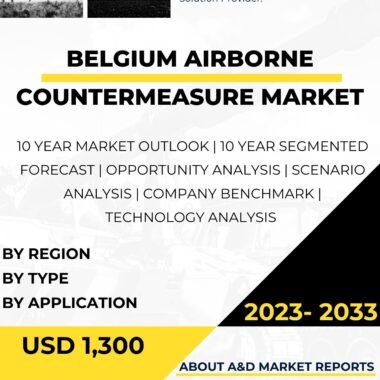Description
Canada’s adoption of airborne countermeasures represents a crucial aspect of its defense strategy, aimed at enhancing aircraft survivability and protecting against hostile threats. Airborne countermeasures encompass a range of defensive measures and technologies designed to detect, evade, and neutralize threats from enemy weapons, such as surface-to-air missiles and anti-aircraft artillery.
One of the primary airborne countermeasures employed by the Canadian Armed Forces is the use of electronic warfare (EW) systems. These systems are integrated into Canadian military aircraft, providing electronic countermeasures (ECM) capabilities to disrupt and degrade enemy sensors, communications, and targeting systems.
Electronic warfare systems work by emitting powerful electronic signals to jam or confuse hostile radar and communication systems. By disrupting the enemy’s ability to detect and track aircraft accurately, electronic warfare systems significantly reduce the effectiveness of anti-aircraft weapons and surface-to-air missiles.
Furthermore, airborne electronic warfare platforms, such as the EA-18G Growler, are capable of suppressing enemy air defenses and creating a protective electronic umbrella around friendly aircraft. This capability, known as electronic protection (EP), enhances the survivability of Canadian aircraft during operations in contested airspace.
In addition to electronic warfare, Canada utilizes infrared countermeasures (IRCM) systems to protect aircraft against infrared-guided missiles. IRCM systems, commonly known as flares or decoy systems, work by emitting intense infrared heat signatures that divert incoming heat-seeking missiles away from the aircraft.
When a heat-seeking missile is launched towards an aircraft, the IRCM system detects the missile’s infrared signature and launches flares to create multiple heat sources. The missile is then drawn towards the flares, diverting it away from the aircraft and preventing a direct hit.
Canada’s utilization of airborne countermeasures also includes chaff, another type of decoy system. Chaff consists of small metallic strips or fibers that are released into the air from aircraft to create a cloud of reflective material. This cloud confuses enemy radar systems and disrupts their ability to accurately track and target the aircraft.
In addition to defensive countermeasures, Canada also employs offensive countermeasures to neutralize enemy air defenses and mitigate threats. Stand-off jamming and suppression of enemy air defenses (SEAD) missions involve using specialized aircraft, such as the EA-18G Growler, to jam and disrupt enemy radar and communication systems.
These SEAD missions clear the way for other aircraft to conduct offensive operations, such as airstrikes or surveillance missions, by degrading the enemy’s ability to detect and track incoming aircraft.
The deployment of airborne countermeasures involves comprehensive training for aircrews and maintenance personnel. Effective utilization of electronic warfare and decoy systems requires skilled operators who can adapt to rapidly changing threat scenarios.
Training exercises and simulations are conducted regularly to prepare aircrews for real-world situations and to refine tactics, techniques, and procedures. These exercises allow aircrews to practice countermeasure deployment and response to simulated threats, ensuring they are ready to respond effectively during actual operations.
Moreover, airborne countermeasure systems are subject to continuous technological advancements. As defense technology evolves, Canada invests in research and development to stay at the cutting edge of airborne countermeasure capabilities.
Partnerships with defense industry leaders and allied nations facilitate technology transfer and access to the latest developments in airborne countermeasure technology. These partnerships also contribute to the development of innovative solutions to counter emerging threats.
Furthermore, the integration of airborne countermeasures into Canada’s defense strategy is aligned with its commitment to international security and cooperation. Canada actively participates in multinational exercises and coalition operations, contributing its airborne countermeasure capabilities to support global peace and stability.
Additionally, Canada’s involvement in international forums and organizations on electronic warfare and countermeasure issues fosters collaboration and information sharing among like-minded nations.
The successful operation of airborne countermeasures requires a coordinated approach across different branches of the Canadian Armed Forces. Air force, navy, and army units work together to ensure seamless integration of countermeasure systems and response capabilities.
Interoperability with allied forces is also a crucial consideration in the deployment of airborne countermeasures. Canada’s participation in international exercises and missions ensures that its countermeasure systems are compatible and effective when operating alongside those of allied nations.
In conclusion, Canada’s adoption of airborne countermeasures is a critical component of its defense strategy, enhancing aircraft survivability and protection against hostile threats. The use of electronic warfare, infrared countermeasures, and chaff provides Canadian aircraft with defensive capabilities to detect, evade, and neutralize enemy weapons.
Moreover, offensive countermeasures, such as stand-off jamming and SEAD missions, contribute to mitigating threats and neutralizing enemy air defenses. Rigorous training, research, and development efforts, and international cooperation are fundamental to maintaining Canada’s proficiency in airborne countermeasure operations.
By investing in cutting-edge technology and participating in multinational exercises and missions, Canada ensures that its airborne countermeasures remain effective and aligned with its commitment to international security and stability. As threats continue to evolve, Canada’s ongoing dedication to airborne countermeasures ensures that its aircraft remain well-protected and prepared to respond to emerging challenges in the dynamic and complex operational environments of the modern era.




